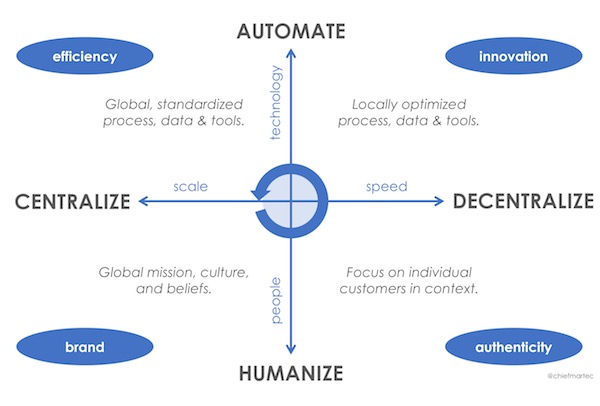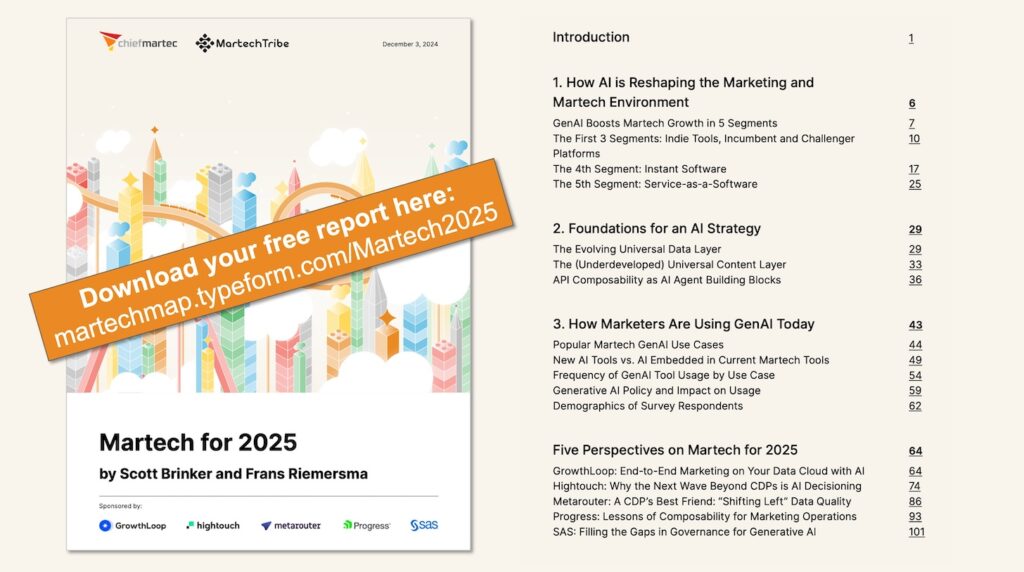As I’ve been preparing for the upcoming MarTech conference in Boston, I have been thinking about the fundamental forces that marketing technology and operation professionals wrangle in their work.
I believe there are two overarching challenges in marketing operations today:
- Our environment is continuously changing, often quite rapidly.
- We have to gracefully balance opposing concepts and objectives.
The struggle of continuous change is something that I’ve discussed previously with Martec’s Law, what I consider to be the greatest management challenge of the 21st century: reckoning fast-changing technology with (relatively) slow-changing organizational dynamics. It’s why I advocate for agile marketing and made that the focus of my book, Hacking Marketing.
But what are the opposing forces that we need to balance in marketing operations?
I specify “marketing operations” instead of marketing more broadly, because this isn’t intended to be a strategy framework. There are plenty of those out there already. Let’s assume we have a good strategy. Now, our job is to effectively manage marketing operations and technology to successfully realize that strategy.
As illustrated at the top of this post, I see two axes balancing four forces:
- Centralization vs. Decentralization
- Automation vs. Humanization
I have a few preliminary thoughts on the dynamics between these forces, but I’d love to hear your thoughts and perspective.
Centralize vs. Decentralize
One of the main responsibilities of marketing operations and technology management is to centralize processes, data, and tools that span the marketing organization as much as possible. In larger companies, this often includes different regions and possibly even multiple business units. This drive is primarily about achieving benefits of scale:
- Share common customer data to deliver a more consistent customer experience
- Standardize other data formats and repositories for global analytics and insights
- Eliminate redundant or duplicate tools in the global marketing stack
- Establish repeatable processes that drive operational efficiency and brand consistency
We’ll talk more about the other axis in a moment, but we centralize automation primarily for efficiency, while we centralize humanization to define our brand. What does everyone in the marketing organization hold to be true with our mission, culture, and beliefs?
But here’s the tricky part.
We also need to support decentralization too. In fact, not just support it, but proactively enable it and enthusiastically encourage it.
Wha-what?
See, for all the benefits of centralization, we also need to decentralize, to empower individuals and teams across the organization to pioneer new tools and processes that diverge — at least initially — from the centralized standard. This other side of the spectrum is about tapping the benefits speed (and adaptability) over scale:
- Optimize workflow and outcomes in the “local” context of a particular team
- Experiment with new ideas and technologies quickly, with minimal red tape
- Serve individual customers in the context of their specific situation
- Encourage distributed leadership for employees to discover, learn, and grow
- “When the map and the terrain differ, trust the terrain.”
With automation and technology, decentralization is often the fire where innovation is forged — it is faster and easier to try something, without herding global consensus or running the gauntlet of multiple stage-gate approvals from a centralized committee.
Remember, most experiments don’t work. The goal is to experiment quickly and cheaply with relatively low risk. The duds get filtered out in real-world practice with minimal overhead. The winners can grow into “local” best practices (i.e., for a particular tactic or team). In time, some may get promoted up to a centralized standard, if they’re globally applicable (not all of them will be).
So which is better, centralization or decentralization?
Both, of course.
Every marketing organization needs to balance these two forces to some degree. The answer as to where that balance should be, however, is not universal. It depends on the company, its strategy, its capabilities, and a particular moment in time.
The trade-offs made between centralization and decentralization change over time. It’s usually a pendulum: a company may become too centralized, sapping its agility, so it will then lean into decentralizing more power and control. If it becomes too de-synchronized or siloed as a result, it will then pull back through greater centralization.
Often specific events, such as a new competitive threat, a big missed opportunity, or a major customer failure will trigger an explicit, top-down rebalancing. But the balance is continuously shifting in small ways through the natural course of business.
Automate vs. Humanize
The other axis of opposing forces that marketing operations leaders must carefully manage is the balance between automation and “humanization.”
The automate end of this spectrum is pretty obvious. After all, there’s a whole category of “marketing automation” software that you could argue sparked the modern marketing operations revolution as we know it. The top half of our illustration is focused on harnessing marketing technology as a competitive advantage:
- Architect a coherent marketing stack and keep it aligned with strategy
- Evaluate, integrate, operate, and maintain martech systems at a global level
- Establish good governance for decentralized marketing technology
- Build organizational capital around technology investments (processes & know-how)
- Champion automation as an opportunity to deliver better customer experience
- Collect, groom, harness, and protect customer and marketing data as a core asset
- Orchestrate the flow between decentralized and centralized data and technology
But bots and automation don’t automagically create a great customer experience. Good marketing operations leaders also invest in the people end of the spectrum:
- Keep human judgement in the loop (or at least carefully overseeing the loop)
- Train people on applying marketing technology in ways that are good for customers
- Encourage peer-to-peer learning and experimentation for continuous improvement
- Review automated processes and tools through the lens of brand culture & values
- Empower individuals to override automation when necessary to best serve customers
- Enable and inspire creativity, empathy, imagination — the best of what makes us human
- Avoid Jurassic Park: “Your scientists were so preoccupied with whether or not they could that they didn’t stop to think if they should”
While the automation half of the spectrum is often the source of efficiency and innovation — at least technological innovation — the human half of the spectrum is where the ideal of a brand actually lives and delivers authenticity on the decentralized edge of the organization.
Is it better to be more automated or more human?
Again, the answer is both. Rather than either/or, it’s really “and.” It’s a balance between these two forces, both happening at the same time.
The right mix and balance for any given organization depends on their unique circumstances and identity. As with the tension between centralize vs. decentralize, it’s not a fixed point along a scale, but a continuous ebb and flow.
A company that leans too far into automation risks losing touch with its customers (and its own employees). At the same time, an organization that leans too far away from automation risks missing out on opportunities to better serve customers through the innovation and efficiency that technology can enable.
“Automate” and “Humanize” aren’t mirror opposites to the same degree that “Centralize” and “Decentralize” are, so this model doesn’t have perfect mathematical symmetry.
But I might suggest that this in itself is a good example of the human side of the spectrum — something that feels right in practice, even if strict computable logic would be unable to solve this numerically.
It’s not easy, but balancing — and rebalancing — these forces seems like the right way to frame marketing operations, especially in a world of constant change.
What do you think?
P.S. We’ll be covering topics like this — a little in theory, but more in practice — at MarTech in Boston, October 1-3. The discounted “beta” rate for tickets expires September 1, so if you’d like to join us, reserve your seat soon.




Terrific post Scott. The matrix, so simple, and obvious when someone shows it to you.
The complex explained!
To the point. Suggestion: Automate – Empathize
Well-said! I’m living this today, moving from centralized to decentralized. The centralization was ideal for normalizing a recent + complex implementation of Marketo, but now as we move to a decentralized model, the challenges are governance and ensuring that the nuances of how it was built are understood, especially for reporting efficacy.
Awesome post, I really like that matrix. Thanks for this
This visual tells a story for sure. I like and thank you. I would go further… decentralized may have a negative connotation… maybe replace with Edge Technology? Just a thought. Nice work Scott… as usual!
Great stuff, centralize vs. decentralize is especially interesting.
There is also a healthy tension between risk and compliance for regulated environments, if you need a z access 😉
Well-said! I’m living this today, moving from centralized to decentralized. The centralization was ideal for normalizing a recent + complex implementation of Marketo, but now as we move to a decentralized model, the challenges are governance and ensuring that the nuances of how it was built are understood, especially for reporting efficacy.
In Electrical safety purpose if you want to know just visit here https://fluketools.blogspot.com/